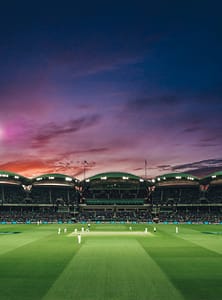North Terrace
A handsome tree-lined boulevard graced by historic and cultural treasures, North Terrace is a great place to kick off a city tour. Parliament House, at the intersection of King William Street and North Terrace, is perhaps the most imposing building in Adelaide with its monumental colonnade. Just down the street, cheek by cheek, the State Library of South Australia, the South Australian Museum, and the Art Gallery of South Australia offer a triple dose of art and culture and are three of the city’s top attractions.
Adelaide Oval
Stadiums aren’t always a top attraction in a capital city, but Aussies love their sports, and this venue is an important part of the city’s history. Sitting in the center of Adelaide’s attractive Riverbank Precinct, the stadium was established in 1871 and hosted its first test cricket match in 1884. Since its founding, the stadium has played host to more than 16 different sports, including AFL, archery, cycling, hockey, lacrosse, and tennis, as well as music concerts and major events.
A multi-million-dollar renovation completed in 2014 revitalized the venue, but it still features the old heritage-listed scoreboard and century-old Moreton Bay fig trees. If you have time, try to buy tickets for a sporting match or event here. Cricket fans should make a beeline for the Bradman Museum to see memorabilia on the life of Australia’s most famous cricketer.
State Library of South Australia
The State Library of South Australia surprises first-time visitors with its dramatic juxtaposition of old and new. The contemporary Spence Wing with its sharp lines and glass-fronted entrance offers modern facilities and free Wi-Fi. From here, ask for directions to the original library, housed in the adjacent 1884 French Renaissance building known as the Mortlock Wing. Entering this grand old space is like stepping back in time. Multi-tiered galleries beckon high above, edged by elaborate wrought iron balustrades, and ladders reach up to leather-bound books neatly propped in the wooden shelves. Highlighting this flashback to libraries of old is a stream of natural light flooding through the glass dome in the roof. The Mortlock Wing is also worth a visit for its special collection of works on the history of South Australia.
Glenelg
In the sheltered and surf-free Gulf St. Vincent, the seaside village of Glenelg is a popular escape from the hustle and bustle of the city. To get here, most visitors opt for the 25-minute trip on Adelaide’s only surviving tram, which departs from Victoria Square in the city center. As well as its beach appeal and many tourist attractions, Glenelg has a fascinating history. The first group of free settlers disembarked from HMS Buffalo in Holdfast Bay here, making this the oldest European settlement on mainland South Australia.
Adelaide Zoo
Adjoining the Adelaide Botanical Gardens on the northwest, the Adelaide Zoo was established in the late 19th century and is much loved for its educational focus and charismatic collection of animals. The giant pandas are the stars here, delighting young and old alike. Other popular attractions are the aviaries, orangutans, and the Envirodome, an interactive visitor center with a vertical garden and terrarium. Kids will love the petting zoo, where they can cuddle, kiss, and feed a cast of furry and feathery farmyard friends, as well as kangaroos, quokkas, and wallabies.
Cleland Wildlife Park
Less than a 20-minute drive from the city center on the northwestern slopes of Mount Lofty, Cleland Wildlife Park cares for a cute and cuddly bunch of Aussie animals in a naturalistic environment. Kangaroos, wallabies, potoroos, and emus roam freely in the wide-open spaces, and you can wander among them, feed them, and enjoy close-up encounters.
Adelaide Festival Centre
A five-minute walk from North Terrace and Rundle Mall, the Adelaide Festival Centre was Australia’s first multi-functional arts venue and excites both locals and tourists with its lively cultural calendar. Its white tent-like roof structure is a distinctive landmark along the River Torrens. In addition to the large 2,000-seat Festival Theatre, the venue is home to several smaller theaters, a banquet room, light-filled gallery, and an amphitheater for concerts and recitals.
The center hosts the highly regarded Adelaide Arts Festival with theater, opera, ballet, exhibitions, lectures, and readings by writers. Those who don’t have time to attend an event can join a behind-the-scenes tour of the dressing rooms and performance spaces. Ample parking and easy accessibility enhance the appeal of this multi-faceted venue.
Victoria Square
In the heart of the city, at the intersection with Grote Street and Wakefield Street, King William Street opens out into the revamped Victoria Square, an event venue with beautifully laid out gardens. The square is also known by its aboriginal name, Tarndanyangga. In the shadow of the modern high-rise blocks (among them the Hilton Hotel), a few handsome 19th-century buildings have been preserved. On the south side, stands the imposing Magistrates’ Courthouse (1851) with a Doric colonnade, and the Neoclassical Supreme Court (1868). On the east side of Victoria Square lies the Treasury Building adjoining the Town Hall, and St. Francis Xavier Cathedral (1856-1926).
Port Adelaide
Port Adelaide, about 14 kilometers northwest of the city center, is a popular tourist destination with museums, restaurants, and well-preserved heritage buildings. Much of the town is a State Heritage Area. A number of imposing 19th-century buildings such as the 1879 Customs House and the Courthouse bear witness to this city’s early prosperity as a thriving port.

